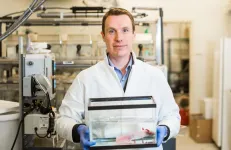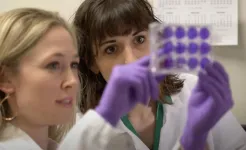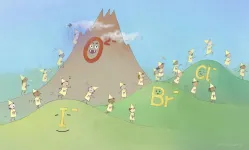People of color twice as likely to die after traumatic brain injury, new study finds
OHSU co-authors say findings are a call to address structural racism throughout society
2021-06-02
(Press-News.org) People of color are more than twice as likely to die after a traumatic brain injury as white people, according to a new retrospective review from Oregon Health & Science University.
The study published today in the journal Frontiers in Surgery.
In the report, "Racial and Ethnic Inequities in Mortality During Hospitalization for Traumatic Brain Injury: A Call to Action," the researchers analyzed more than a decade of data related to the health outcomes and demographics of thousands of patients treated for traumatic head injuries at OHSU Hospital, one of two Level 1 trauma centers in the state.
They found a clear delineation of worse outcomes for people of color.
"We have a societal and professional duty to recognize and accept that the effects of structural racism have taken hold of our patients' health long before they arrive in our trauma bays, ICU beds, and operating tables," they write. "These disparities permeate our society and contribute to inequitable health outcomes, and we must take action to identify the factors which perpetuate this disproportionate suffering."
The researchers found no bias in the treatment patients received while in the hospital. Measurements including the number of days spent in intensive care and charges for hospital services were similar between groups.
Rather, they say the findings highlight underlying disparities in health that disproportionately affect people of color.
"If you ran the same analysis with patients with pneumonia, you might find the same results," said senior author Ahmed M. Raslan, M.D., FAANS, associate professor of neurological surgery in the OHSU School of Medicine. "Our findings point to the problem in a more robust and clear way. The problem is rooted in social determinants of health, including factors such as diet, lifestyle, occupations and access to health care."
The study is the first to review racial and ethnic disparities in the field of neurosurgical trauma.
Researchers reviewed outcomes for 6,352 patients treated for traumatic brain injuries between 2006 and 2017. The overall mortality rate was 9.9% among all patients. Among the 1,504 patients who identified as racial or ethnic minorities, 14.6% died.
Weighted for severity of injury, age and other factors, researchers calculated an in-hospital mortality hazard ratio of 2.21 for minority patients compared to white patients.
"Dr. Raslan's research is incredibly important in highlighting disparities in health outcomes experienced by people of color," said Nathan Selden, M.D., Ph.D., professor and chair of neurological surgery in the OHSU School of Medicine. "Together with our department's efforts to improve the care of traumatic brain injuries, and more broadly to improve diversity in medicine, I am confident OHSU can really make a difference."
INFORMATION:
Co-authors along with Raslan included Emma A. Richie, the lead author, and Joseph G. Nugent, students in the OHSU School of Medicine who conducted this line of research in the Department of Neurological Surgery under Raslan's mentorship.
ELSE PRESS RELEASES FROM THIS DATE:
2021-06-02
Hydrogels are commonly used inside the body to help in tissue regeneration and drug delivery. However, once inside, they can be challenging to control for optimal use. A team of researchers in the Department of Biomedical Engineering at Texas A&M University is developing a new way to manipulate the gel -- by using light.
Graduate student Patrick Lee and Dr. Akhilesh Gaharwar, associate professor, are developing a new class of hydrogels that can leverage light in a multitude of ways. Light is a particularly attractive source of energy as it can be confined to a predefined area as well as be finetuned by the time or intensity of light exposure. Their work was recently published in the journal Advanced Materials.
Light?responsive hydrogels are an ...
2021-06-02
OAKLAND, Calif. -- In patients with insulin-treated type 2 diabetes, the use of continuous glucose monitors is associated with better blood sugar control and fewer visits to the emergency room for hypoglycemia, a Kaiser Permanente study published June 2 in the journal JAMA found.
The monitors have previously been shown to improve glucose control for patients with type 1 diabetes. Continuous glucose monitors are now the standard of care for these patients.
"The improvement in blood sugar control was comparable to what a patient might experience after starting a new diabetes medication," said the study's lead author Andrew J. Karter, PhD, a senior research scientist with the Kaiser Permanente Northern California ...
2021-06-02
What The Study Did: Researchers investigated the effect of real-time continuous glucose monitoring on glycemic control among patients with insulin-treated diabetes.
Authors: Andrew J. Karter, Ph.D., of Kaiser Permanente in Oakland, California, is the corresponding author.
To access the embargoed study: Visit our For The Media website at this link https://media.jamanetwork.com/
(doi:10.1001/jama.2021.6530)
Editor's Note: The article includes conflict of interest and funding/support disclosures. Please see the article for additional information, including other authors, author contributions and affiliations, conflict of interest and financial disclosures, and funding and support.
INFORMATION:
Media advisory: The full study and editorial ...
2021-06-02
BAR HARBOR, MAINE — Many salamanders can readily regenerate a lost limb, but adult mammals, including humans, cannot. Why this is the case is a scientific mystery that has fascinated observers of the natural world for thousands of years.
Now, a team of scientists led by James Godwin, Ph.D., of the MDI Biological Laboratory in Bar Harbor, Maine, has come a step closer to unraveling that mystery with the discovery of differences in molecular signaling that promote regeneration in the axolotl, a highly regenerative salamander, while blocking it in the adult mouse, which is a mammal with limited regenerative ability.
"Scientists at ...
2021-06-02
Researchers from Carnegie Mellon University's Computational Biology Department in the School of Computer Science have developed a new process that could reinvigorate the search for natural product drugs to treat cancers, viral infections and other ailments.
The machine learning algorithms developed by the Metabolomics and Metagenomics Lab match the signals of a microbe's metabolites with its genomic signals and identify which likely correspond to a natural product. Knowing that, researchers are better equipped to isolate the natural product to begin developing it for a possible drug.
"Natural products are still one of the most successful paths for drug discovery," said Bahar Behsaz, a project scientist in the lab and lead author of a paper about the process. "And ...
2021-06-02
A team of Colorado State University scientists, led by veterinary postdoctoral fellow Dr. Anna Fagre, has detected Zika virus RNA in free-ranging African bats. RNA, or ribonucleic acid, is a molecule that plays a central role in the function of genes.
According to Fagre, the new research is a first-ever in science. It also marks the first time scientists have published a study on the detection of Zika virus RNA in any free-ranging bat.
The findings have ecological implications and raise questions about how bats are exposed to Zika virus in nature. The study was recently published in Scientific Reports, a journal published by Nature Research.
Fagre, a researcher at CSU's Center for Vector-Borne Infectious Diseases, ...
2021-06-02
ITHACA, N.Y. - All fish are not created equal, at least when it comes to nutritional benefits.
This truth has important implications for how declining fish biodiversity can affect human nutrition, according to a computer modeling study led by Cornell and Columbia University researchers.
The study, "Declining Diversity of Wild-Caught Species Puts Dietary Nutrient Supplies at Risk," published May 28 in Science Advances, focused on the Loreto region of the Peruvian Amazon, where inland fisheries provide a critical source of nutrition for the 800,000 inhabitants.
At the same time, the findings apply to fish biodiversity worldwide, as more than 2 billion people depend on fish as their primary source of animal-derived nutrients.
"Investing in safeguarding biodiversity can deliver ...
2021-06-02
Researchers at Kyoto University's Institute for Cell-Material Sciences (iCeMS) have developed a new approach to speed up hydrogen atoms moving through a crystal lattice structure at lower temperatures. They reported their findings in the journal Science Advances.
"Improving hydrogen transport in solids could lead to more sustainable sources of energy," says Hiroshi Kageyama of iCeMS who led the study.
Negatively charged hydrogen 'anions' can move very quickly through a solid 'hydride' material, which consists of hydrogen atoms attached to other chemical elements. This system is a promising contender for clean energy, but the fast ...
2021-06-02
Stone tools have been made by humans and their ancestors for millions of years. For archaeologists these rocky remnants - lithic artefacts and flakes - are of key importance. Because of their high preservation potential they are among the most common findings in archaeological excavations. Worldwide, numerical dating of these lithic artefacts, especially when they occur as surface findings, remains a major challenge. Usually, stone tools cannot be dated directly, but only when they are embedded in sediment layers together with, for example, organic material. The age of such organic material can be constrained via the radiocarbon technique. If such datable organic remains are ...
2021-06-02
Tested on human blood in the lab, the selective nanocapsules could reduce the side effects of a major blood clot dissolving drug, which include bleeding on the brain. If confirmed with animal tests, the nanocapsules could also make the drug more effective at lower doses.
Blood clots, also known as thrombi, are a key cause of strokes and heart attacks which are leading causes of death and ill-health worldwide. They can be treated with a clot dissolving drug called tissue plasminogen activator (tPA) which disrupts clots to clear the blocked blood vessel and re-establish blood ...
LAST 30 PRESS RELEASES:
[Press-News.org] People of color twice as likely to die after traumatic brain injury, new study finds
OHSU co-authors say findings are a call to address structural racism throughout society




